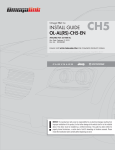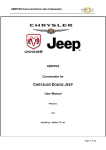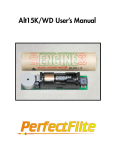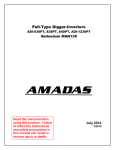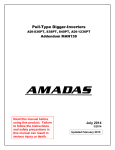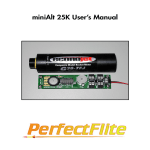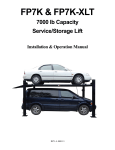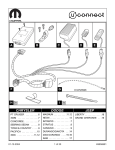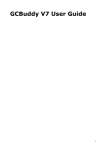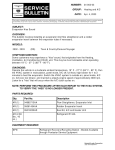Download SUBJECT: Radio Communication Equipment Installation
Transcript
NUMBER: GROUP: DATE: 08-024-05 Electrical May 4, 2005 This bulletin is supplied as technical information only and is not an authorization for repair. No part of this publication may be reproduced, stored in a retreival system, or transmitted, in any form or by any means, electronic, mechanical, photocopying, or otherwise, without written permission of DaimlerChrysler Corporation. SUBJECT: Radio Communication Equipment Installation Recommendations MODELS: 2001 - 2003 (AB) Ram Van/Wagon 2001 - 2004 (AN) Dakota 2001 - 2002 (BR/BE) Ram Pick Up 2004 - 2006 (CS) Pacifica 2005 - 2006 (DH) Ram Pick Up - Heavy Duty 2001 - 2003 (DN) Durango 2002 - 2006 (DR) Ram Pick Up 2004 - 2006 (HB) Durango 2001 - 2006 (JR) Stratus/Sebring 2002 - 2006 (KJ) Liberty/Cherokee 2006 (LE) Chrysler 300 (International Markets) 2001 - 2004 (LH) Intrepid/Concorde/300M 2005 - 2006 (LX) 300/Magnum/Charger 2005 - 2006 (ND) Dakota 2001 - 2005 (PL) Neon 2001 - 2002 (PR) Prowler 2002 (PG) PT Cruiser (International Markets) 2001 - 2006 (PT) PT Cruiser 2001 (R1) Dakota (International Markets) 2001 - 2006 (RS/RG) Town & Country/Caravan/Voyager 2001 - 2002 (SR) Viper RT/10 & GTS Coupe 2001 - 2005 (ST) Stratus Coupe/Sebring Coupe 2001 - 2006 (TJ) Wrangler 2004 - 2006 (VA) Sprinter 2001 - 2004 (WJ/WG) Grand Cherokee 2005 - 2006 (WK/WH) Grand Cherokee 08-024-05 -2- 2006 (XK/XH) Commander 2001 (XJ) Cherokee 2003 - 2006 (ZB) Viper 2004 - 2006 (ZH) Crossfire Coupe/Crossfire Roadster DISCUSSION: The information contained in this guide has been prepared for use by persons installing two-way radio equipment (transmitters and receivers) in vehicles. It has been prepared in accordance with current engineering principles and generally accepted practices, using the best information available at the time of publication. It is not possible to cover all of the possible installations of two-way radio equipment in this guide. Accordingly, DaimlerChrysler Corporation cannot be held responsible for incidental or consequent damages arising out of the use of the information contained herein. Installations and modifications are solely the customer's responsibility The installation recommendations presented here are intended to supplement the radio manufacturer's instructions. To assist in properly installing communications equipment in DaimlerChrysler vehicles, the following information is provided. Always use good installation practices (see The American Radio Relay League (ARRL) Handbook or other standard reference). Test the entire installation for anomalies, especially drivetrain and brake control before extensive driving. If any problems occur the owner's first line of contact is the vehicle dealer. The literature supplied with each vehicle lists the steps to be taken in the event the dealer is unable to resolve the problem. CONTROLS Mount the transceiver to a solid surface. If you use screws through the floor, put body sealer over the underbody projections. Stamped acorn nuts, filled with sealer are available at most body shops for this purpose. This will keep moisture out of the carpet and insulation, and will forestall rust in this area. Watch out for wire harnesses routed under carpet and behind the instrument panel. Do not drill holes. Instead, use an awl to pierce the hole. Not only is damage less likely, but the extruded sheet metal will resist strip out much better. If you mount the radio under the instrument panel, be sure that there is no interference with proper operation of the foot controls. Mount the control head or front panel (especially the microphone cable) so that it is clear of the steering wheel and steering column controls and passenger airbag. If the unit is heavy, extra bracing may be needed for stability. Newer vehicles have more structure and energy absorbing materials in the knee blocker (the lower part of the Instrument Panel). A communications speaker (with or without DSP), directed toward the operator, will enhance intelligibility under mobile conditions. Many factory entertainment radios have a “mute audio” input that may be used with the Push-To-Talk (PTT) line to mute the audio system during transmit. This information is usually in the service manual. Try the installation out before you start drilling holes (Velcro or other hook-and-loop is useful). POWER WIRING -3- 08-024-05 To reduce the hazard of working on the vehicle, disconnect the NEGATIVE battery cable before beginning work. NOTE: Some components may lose short-term memory (e.g.: engine or transmission adaptive parameters, radio presets etc.) after an extended length of time without battery power. For low or medium power transmitters (up to 55W FM or 110W SSB or CW), the interior power distribution center or the power outlet or cigar lighter feed may be used. Use an appropriate jumper terminal at the socket or splice (solder and heat shrink or tape). For higher power transmitters, including amplifiers, connect the power (battery positive) lead at the battery or at the power distribution center or at the positive jump-start post, if equipped. If ignition switching is desired, use a relay to prevent overloading the ignition switch. Appropriate terminals should be used. If a terminal is exposed to the weather, solder and apply a commercial protectant (wheel bearing grease is an acceptable alternative) to retard corrosion. The power lead should be fused as close to the battery as practical to protect the wiring and the vehicle! If the power connection is underhood, use a weatherproof fuse holder. These are usually available from a trailer supply or marine dealer. Vinyl-insulated wire, typically supplied with transceivers is not entirely suitable for the higher underhood temperatures in modern vehicles. Route the underhood wiring away from all hot areas, away from the exhaust, radiator, A/C liquid line and engine. Along body sheet metal is usually the coolest location. DO NOT FUSE THE GROUND LEAD! If the ground-side fuse were to open, the entire supply current would be conducted by an alternate current return path, which may cause the feed line to overheat, with possible resulting damage. For low or medium power installations, connect the ground (battery negative) to body sheet metal near the power feed point. If you use a screw through the floor, use body sealer over the underbody projection. For high power installations, connect the ground (battery negative) lead at the battery connection to the body. This is usually a 6 or 8 AWG black wire from the battery negative terminal to a screw at the wheelhouse or radiator support. If a separate sheet metal ground is used, clean the paint off a one inch or so diameter area of body panel where the ground lead is to be connected. An awl is the best tool to use to pierce a starting hole for a #12 or 5mm, minimum, plated ground screw. A flat ring terminal of the proper size for the screw with separate serrated washer (not a split or SAE) lock washer should be used between the terminal and the screw head, not between the terminal and the surface. As above, some grease or protectant should be used if the connection is in an unprotected area. It may be possible to route power wires through the hood gutter into the door gap, into the passenger compartment. If the power cable must pass through the dash panel, try to find an existing hole with a grommet that is unused. If none is available, pull the carpet back from under the dash panel in the passenger footwell in the cabin. Locate a place where there are no other components on either side, as high up as possible. An awl is the best tool to use to punch a small hole through to the engine compartment. If the position is good, enlarge the hole by driving the awl in up to the shank. If this is not large enough to easily pass the cable, enlarge it by using a larger tapered punch. This will leave an extruded hole with no sharp edges. Install the cable and seal the hole with silicone RTV or commercial body sealer on both sides. Seal any extra holes that you may have made. 08-024-05 -4- Dress the underhood wiring so that it is safe from all hazards, which include the following: exhaust manifold, steering shaft, throttle linkage, fans, etc. Provide a outside drip loop where wires pass through the compartment panels and tie wrap or tape as required keeping the wires where you put them. CABLING Route control cables under the floor mats, inside the corner where the floor pan meets the rocker panel for best protection. Remove the sill plates and tuck the cable under the floor mats or carpet and padding. For most left hand drive vehicles, use the right side for best separation to the main body harness which is usually on the left side. Route the cable along the extreme outboard edge of the floor pan, under the side trim, if possible. REMOTE TRANSCEIVER For trunk mount installations in passenger cars, you may need to remove the rear seat cushion and seat back to get the cable into the trunk. The seat cushion is usually clipped at the front, lower edge by its own frame: push down and back, then lift. Note the front and rear clipping points for ease of reinstallation. The seat back is usually clipped to the rear compartment inner panel: pull out at the bottom and slide up to remove. Again, note the clipping points for ease of reinstallation. There is usually a vapor/sound barrier behind the seat back, which must be pierced to pass the cable through. Open the trunk and pick a spot where the cable is safe from chafing on any sharp sheet metal. Tie wrap or tape in place at this location. Repair the barrier sheet if necessary. Replace the seat back and cushion, taking care that the cable is not pinched by the seat cushion when there is someone sitting in the seat. On some vehicles, there may be a channel for wiring at this location. Newer vehicles have seatbacks that fold down, which may provide a very simple pass through method. Watch for and avoid pinch points! For remote control radios, a sheet of 1/2" plywood one or two inches larger than the radio, is a good method to mount the transceiver to the shelf. It provides a good mounting surface, some shock and vibration isolation, and it keeps moisture away from the radio. Mounting on the floor of the trunk is not recommended. To conserve trunk space, in some vehicles, the radio may be mounted to the rear compartment panel. Locate as far as possible from any vehicle electronic modules located in the rear of the vehicle. In any case, provide good air circulation; a 50 watt RF output FM transmitter will dissipate about 22 watts (@70% efficiency). Do not obstruct the cooling air flow. TRANSMISSION LINE The transmission line (coaxial cable) should be treated in the same way as the control and power cables. Route flat along body sheet metal wherever possible to avoid sharp edges and pinches. If it is necessary to cross over wiring, cross at right angles. In some cases, additional grounded shielding between the transmission line and the vehicle wiring may be helpful. It is important to maintain the maximum spacing from the vehicle harnesses, especially if the antenna is not a good match. Use the best cable available (98-99% braid coverage or braid/foil) especially at VHF and above. Mechanical pressure on the cable can cause degradation or even short circuits. Do not rely on the obsolete military 'RG' designations as an indicator of quality. Cut off excess transmission line, coiling forms a choke balun, and terminate in the correct connector. -5- 08-024-05 The use of N, BNC or C connectors are recommended over "UHF" (PL-259/SO-239) connectors. A small amount of silicone dielectric grease (not the white heat sink compound) in the connector (after soldering) will minimize condensation problems. Cut the line as short as practical, to minimize losses. ANTENNA LOCATION Antenna location is the most important consideration in any mobile installation. For VHF and UHF antennas the recommended place on almost all vehicles is in the center of the roof. Antenna mounting location must not cause radiation into the passenger compartment. NOTE: There may be GPS, cellular, satellite radio or newer technology antennas located in or on the vehicle. They may contain sensitive low noise amplifiers (LNAs), operating at 0.9, 1.575 and/or 2.3GHz. If you are unsure of interactions, test with a temporary installation (a magnetic mount will do) before committing to a permanent hole. Deck lid installation is not recommended. Glass-mounted antennas should be mounted at the very top edge of the clear portion of the glass away from the heater grid. Vehicles with printed-on-glass (active) antennas may be damaged by through-glass installations. NOTE: Composite panels, such as roof or deck lid may contain hidden receiving or transmitting antennas. For HF antennas, refer to the manufacturer's instructions and follow them closely, unless you are an accomplished antenna experimenter. HF antennas should be mounted to the body or frame steel for a good counterpoise as well as structural strength. 2" x 3" aluminum architectural tubing (or 2" x 4" U-channel for heavy HF antennas) may be cut and welded into many simple structures to mount HF antennas, and it is easily modeled by using 2x4s. Aluminum bumpers are heavily anodized for corrosion protection and the coating (aluminum oxide) is very hard as well as non-conductive. A small grinder with a coarse stone will break through the anodized coating for electrical connection. Remember for all monopole antennas, the vehicle is the other half of the radiator. At HF the vehicle may be shorter than a quarter wavelength, resulting in some significant unbalanced currents flowing on the body. ANTENNA INSTALLATION Permanently installed antennas are preferable over magnetic, glass or body-lip mounts for anything other than for low power or temporary installations. Most of these alternate antennas will reflect some power back at the feed point. Much of this will be radiated from the feed line inside the passenger compartment, and may be picked up by the vehicle wiring. For deck lid installations for HF or low VHF (6m), the deck lid should be bonded to the body across the hinges with short, wide tinned braid straps or thin brass strip. They must connect to clean sheet metal at both ends. For AM/SSB and even some FM installations, the hood should be bonded to the body. In some cases, the doors may need to be bonded as well Glass-mount antennas may not work or will only work very poorly in vehicles with metallized glass (Electrically-heated windshields or some solar reflective glass). 08-024-05 -6- Non-metallic bodies (e.g., Viper) require a half-wavelength antenna or a ground plane with radius equal to a quarter-wavelength for a quarter-wave antenna. Copper or brass are the best choices, but aluminum or even steel may be used. Install on the inside of the body panel with a good adhesive or tape and provide a good RF connection to the coax shield at the feed point. Screen, mesh or thin sheet stock, even copper or aluminum tape may be used. Shape is not critical, but some directional characteristics may be noted if it is not round. Try to stay one-quarter wavelength away from edges, including sunroof openings. For VHF and UHF, a good quality "NMO" (New MOtorola) base or other mount with feed line (center conductor and shield) soldered to base is recommended. This will allow the maximum flexibility in antenna selection and is the best choice for electrical and mechanical considerations. Use the proper hole saw 3/4" for NMO, Motorola P/N 0180356B77) or have it done professionally if you are not comfortable with power tools. Consider roof reinforcements and the sunroof mechanism for interference to the base and to the feed line. The dome lamp opening often provides convenient access at or near the center of the roof. Hole plugs are available, for use at sale or trade-in, if you expect to remove the antenna base. To install the antenna base in the hole, remove the one or two-door trim pieces at the pillar where the cable is to be routed and ease the headliner away from the roof. Insert a piece of flat steel or plastic banding ½" to ¾" wide) and guide to the desired corner. Pull the banding through, leaving 6" which can be taped to the transmission line (easier without the connector, but possible even with a PL-259). Continue pulling until the antenna base is one inch or less from the hole, then seat the base and screw on the outside ring, O-ring down. A little silicone grease helps maintain a good seal for the life of the vehicle. Tighten with an open-end wrench, and apply a small amount of silicone grease to the contact and insulator surface of the base. This will help exclude water, but must be renewed periodically. Tip: if you remove your antenna to go through the car wash, there are caps available to exclude water during the process. In most vehicles, RG-58 sized cable will fit between the pillar trim and body sheet metal. If necessary, the technique used on the roof can also be used to snake the cable down the inside the pillar. All radio installations must follow the personal exposure recommendations in FCC Bulletin 65. Install the connector very carefully. There are good instructions in The ARRL Handbook. Use a clean, hot, high-wattage iron and work quickly, to prevent damage to the cable dielectric. If you are a beginner or are not comfortable with this kind of detail work, ask for help. It is extremely important. POLICY: Information Only






